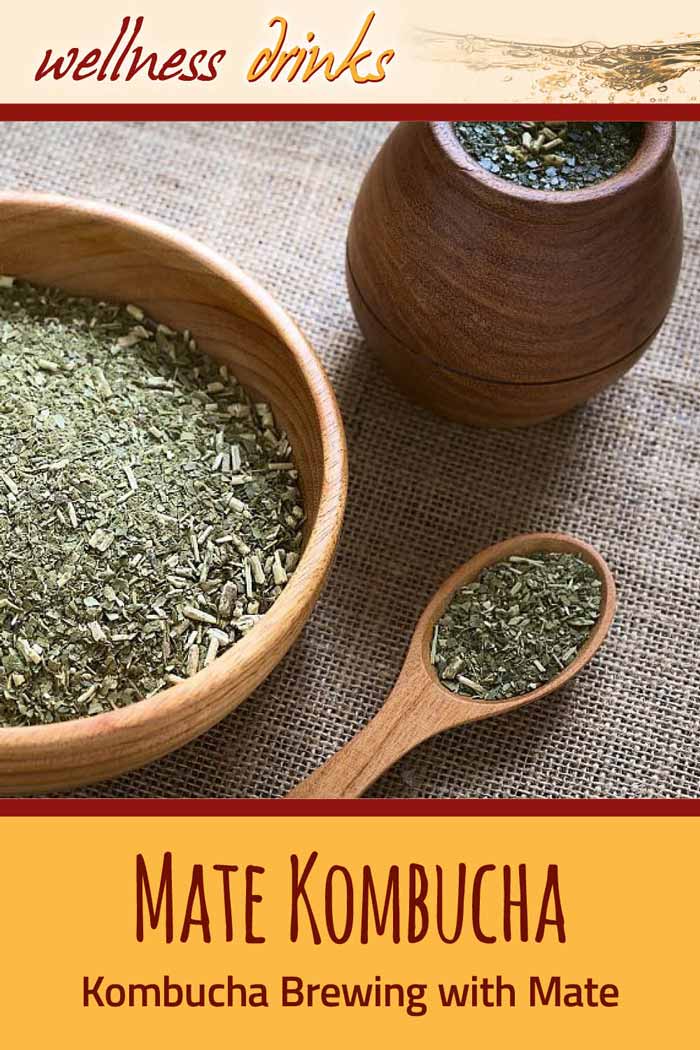Mate Kombucha (Kombucha culture with mate tea)

Mate is already a great thing - especially for those who are looking for a healthy stimulant and pick-me-up, but don't get along so well with coffee in everyday life. Because the tea brewed from the dried leaves of the South American mate shrub makes you wide awake, but does not usually cause nervousness or even palpitations, as many know from too much coffee.
While the effects of coffee often wear off after a short time, mate helps you to stay focused and fit for hours. It has a softer, but longer lasting effect and more on the spiritual level, without burdening the heart and circulation. Mate contains not only caffeine, but also other stimulating, concentration-promoting ingredients such as theobromine. If you want to be focused and "on the job" for hours, Mate is a really good helper!

But here's even more to it than that: Many people who drink Mate report that they also experience a noticeable reduction in signs of physical exhaustion, such as heavy, tired legs and mild headaches. Mate tea also boosts digestion and metabolism. Half an hour after consumption, many people feel a distinct feeling of warmth - a sure sign of an activated metabolism.
Mate even noticeably reduces the feeling of hunger and thus helps with interval fasting. Some scandalmongers say with a twinkle in their eye that mate acts like a mini-dose of cocaine - but without the dangerous properties of the drug. No wonder, then, that many nutritionists and alternative practitioners now recommend Mate, for example to support a diet or as a natural "booster" during exercise, but also simply as a healthy drink rich in tannins and bitter substances.
Before anyone asks: At this point we cannot clearly prove the manifold effects of Mate with studies. However, these are frequent empirical values. Anyone who feels like it should simply try out for themselves how strongly they react to Mate and how well Mate tea is good for them. Fortunately, we do not offer Mate tea in our shop, because otherwise warning lawyers would probably tear the place apart for such "unproven health statements". But since we only tell you the recipe without selling Mate ourselves, we can talk freely and uncensored without having to worry about legal issues... ;-)

So, Mate is a great thing - but even better is that you can brew great Kombucha with it! Mate Kombucha tastes mild and subtle, similar to green tea Kombucha. However, this is accompanied by the typical bitter notes of the Mate leaves and often a slightly smoky aroma (some types of Mate are lightly smoked when dried).
Another important note: Many of the traditional "Yerba Mate", which originate from Argentina, Brazil or Paraguay, are herbal mixtures and contain for example peppermint or other aromatic additives. Although these varieties often taste very delicious, caution is advised when brewing Kombucha. The Kombucha fungus grows best in pure Mate tea without mint, whose essential oils can disturb its growth.

The ingredients for Mate Kombucha (basic recipe):
- 1 Kombucha fungus (Scoby) of Wellness-Drinks with at least 100ml Kombucha drink as preparation liquid
- 1 liter brewed, well cooled Mate tea
- 90-100g sugar
The preparation:
- For one liter of Mate tea, depending on the desired strength, you need about 8-12g of dried Mate leaves (fine or ground), which you infuse with water not boiling any more (90°) and leave to steep for about 12 minutes.
- Dissolve the sugar in the still hot Mate tea and then let it cool down to room temperature.
- Then prepare the Mate tea with aKombucha Scoby and thepreparation liquid as described on our page about making Kombucha with tea.
- After 8-14 days the drink is completely fermented. Mate Kombucha tastes very good when served pure and ice-cold, but can also be served with a few slices of ginger or a little mint.
- The Kombucha fungus (Scoby) grows evenly and cleanly in Mate. The culture succeeds very reliably, even if the new Scoby grows a little slower than usual. It is therefore advisable to divert an excess Scoby for Mate Kombucha and keep a normal culture with tea, prepared according to the classic Kombucha recipe.

One more tip: Mate tea, which is available - usually in tea bags - in German drugstores or supermarkets, is often very expensive. Those who have acquired a taste for it should rather reach for the larger packages of genuine South American varieties. There are enough suppliers on the Internet who import the traditional varieties at low prices (e.g. www.mate-tee.de).
This is worthwhile not only in terms of price and the wider choice of types, flavors and qualities, but also visually! Because the traditional varieties, often sold in the same design for decades, look great in their beautiful, colorful packages. They are a very nice gift and make themselves extremely decorative in any kitchen.
Mate Kombucha (Kombucha Brewing with Yerba Mate)

- Description: Mate Kombucha (Kombucha brewed with Yerba Mate)
- Category: Drinks, Cuisine: American
- Tags: Kombucha, Mate, Yerba Mate, Kombucha brewed with Mate, Kombucha Brewing, Fermentation, Vegan, Kombucha Recipe
- Prep Time: 25 Minutes , Fermentation Time: 10 Days
- Yield: 5 Servings, Nutrition facts (calories): 220 (ca.) per serving,
- Author: Wellness-Drinks, Published: 1.5.2019
Note: All information and tips on our website have been selected and verified by us with great care. Nevertheless, we cannot guarantee for the currency, completeness and validity of the given data. We assume no liability for any damage and or accidents.
When following our recommendations, tips, and notes, please also use your own personal judgment and experience in the proper and safe handling of food.









